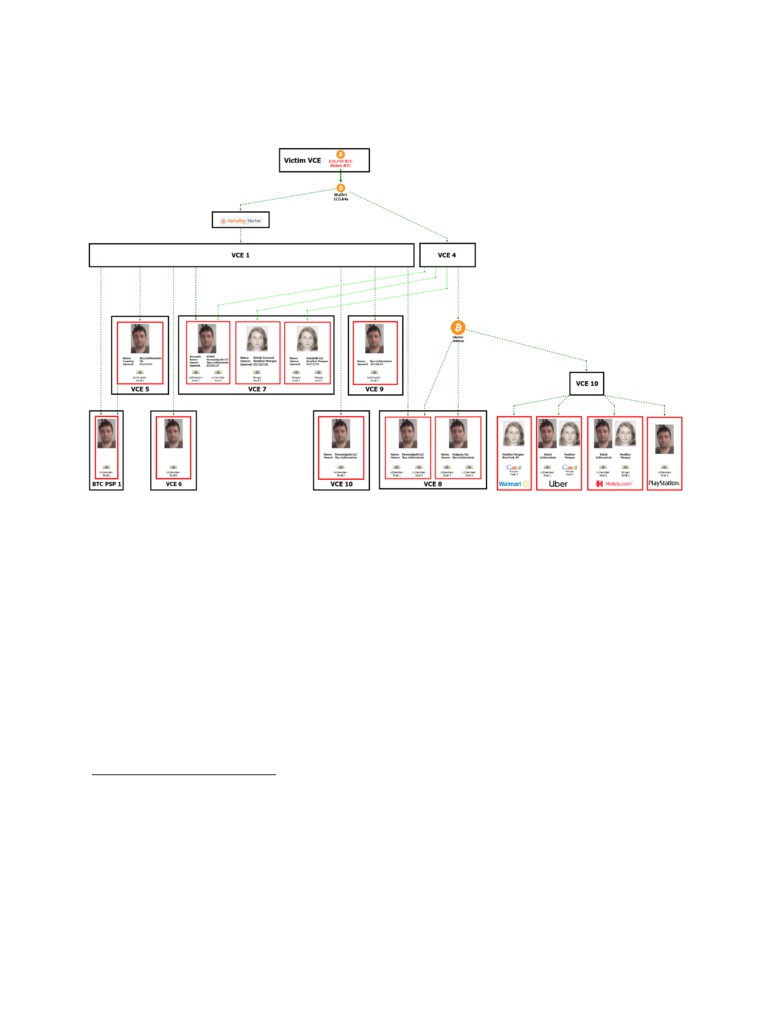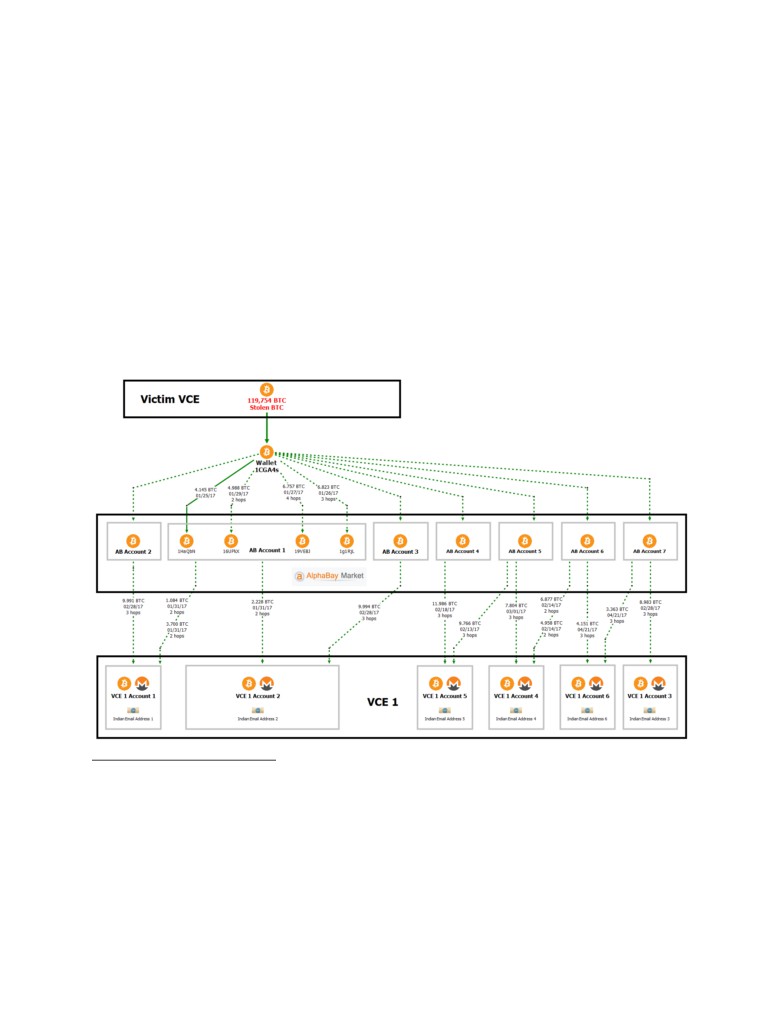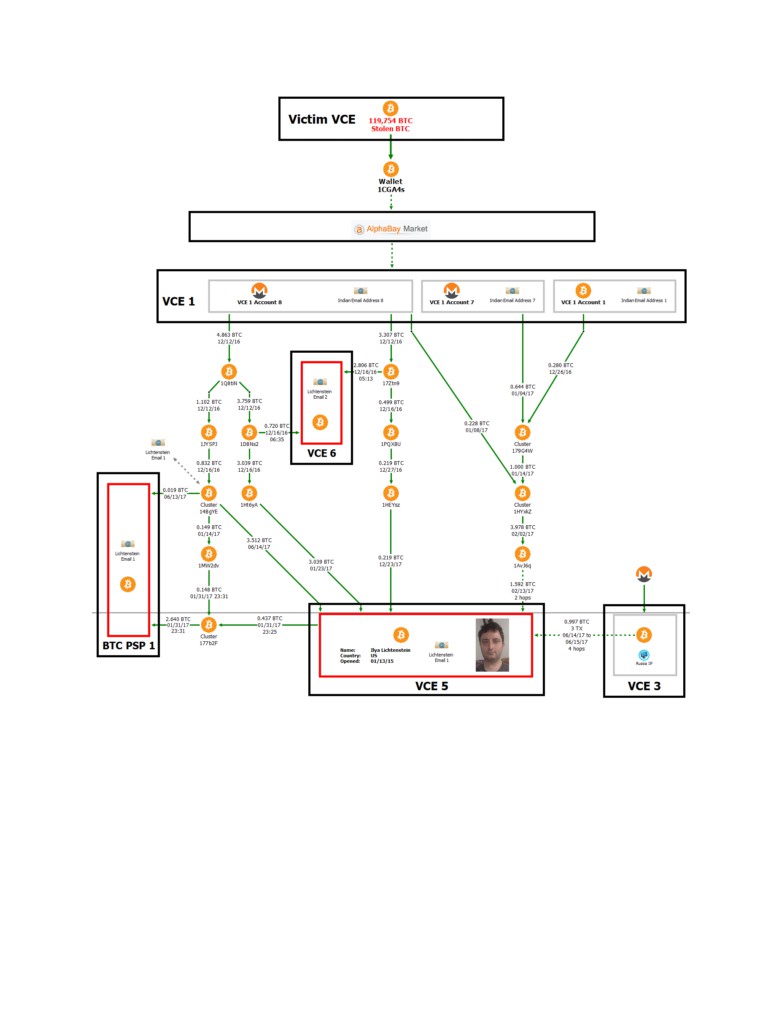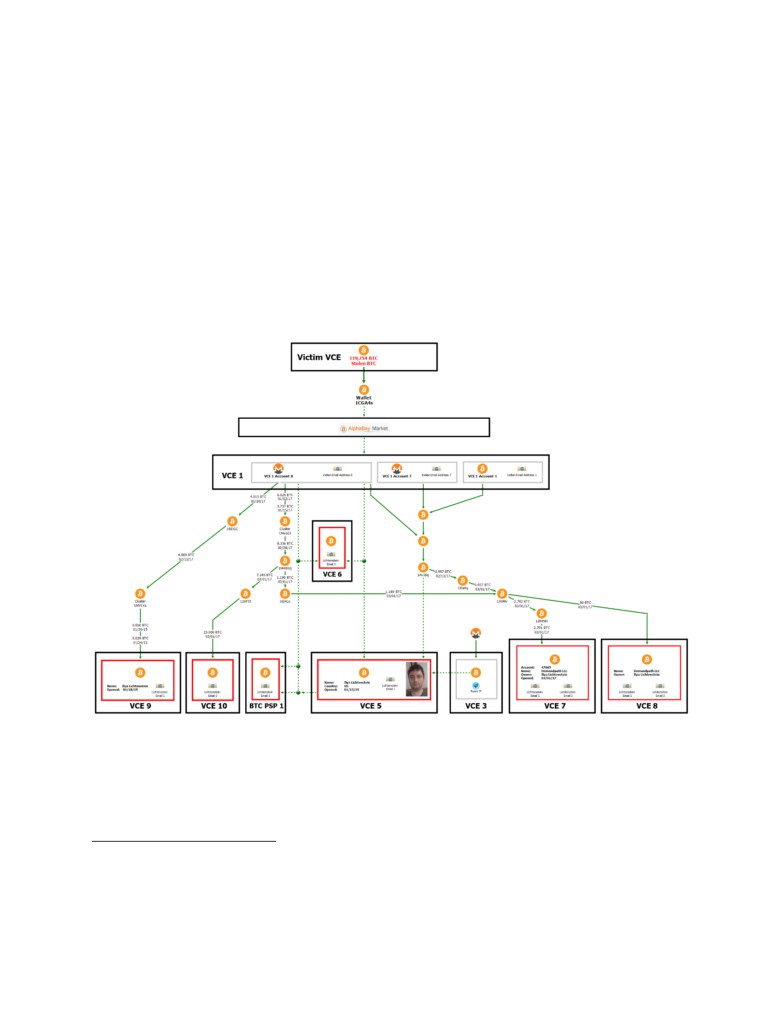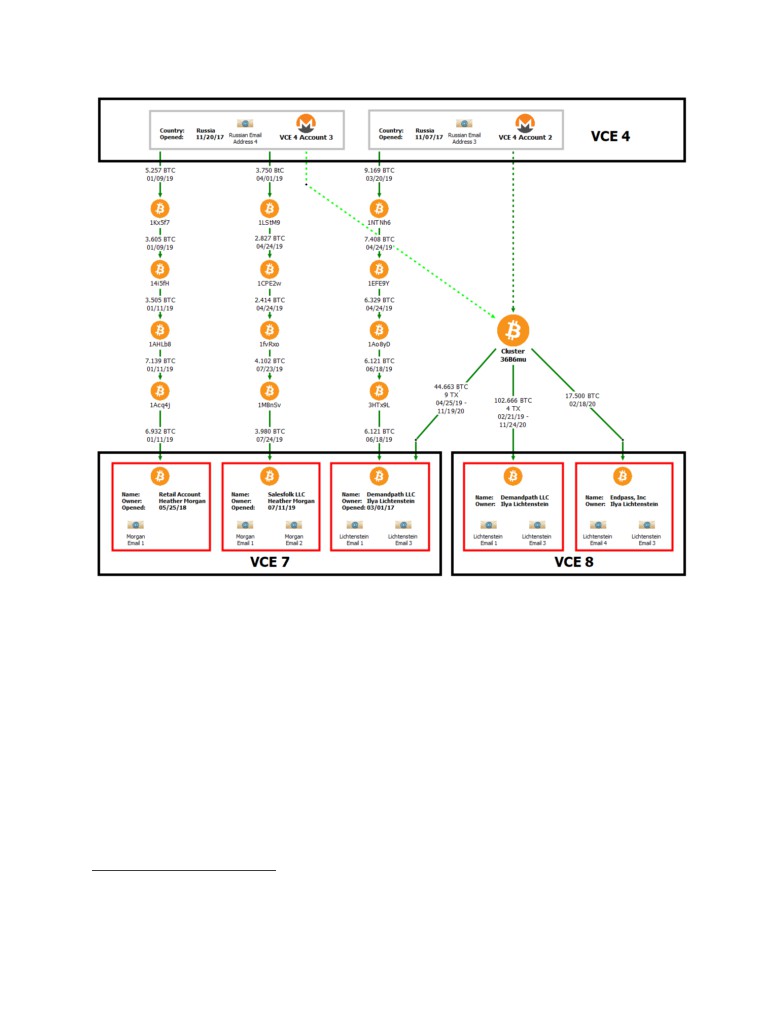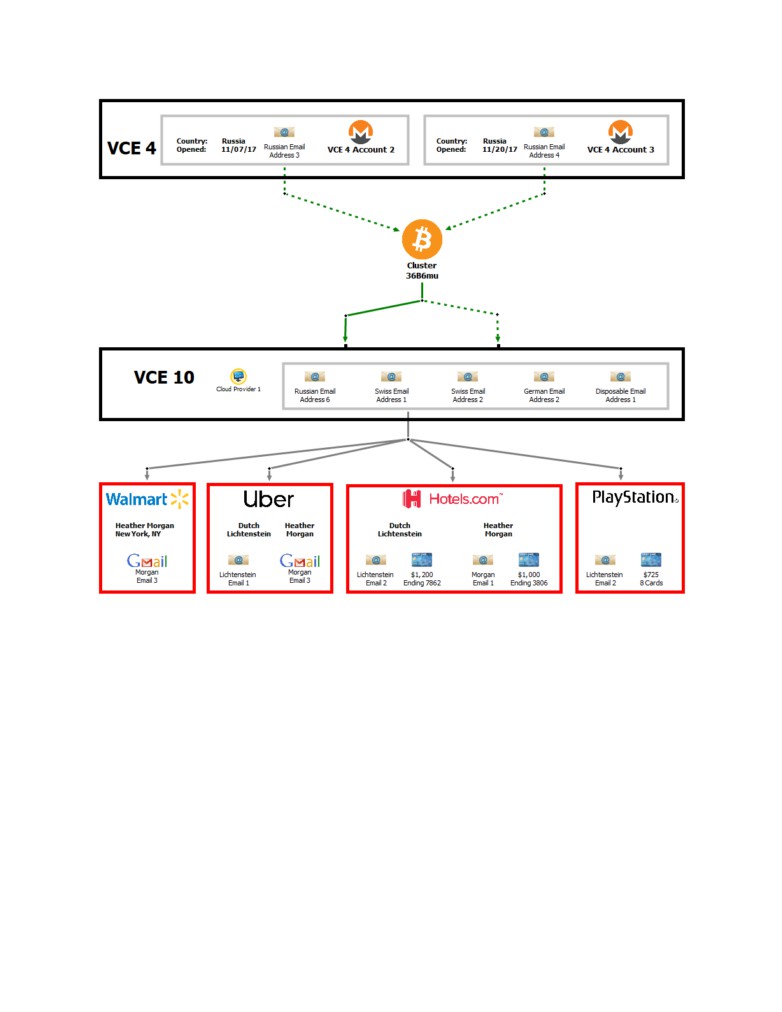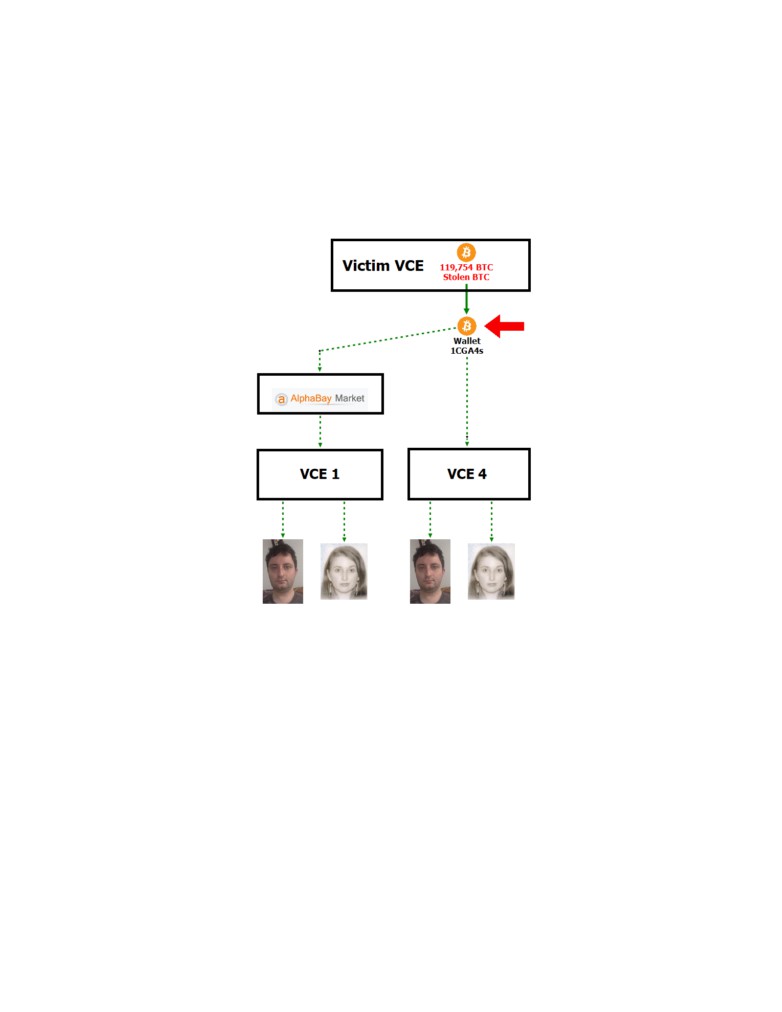Case 1:22-mj-00022-RMM Document 1-1 Filed 02/07/22 Page 1 of 20
STATEMENT OF FACTS
1.
Your affiant, Christopher Janczewski, is a Special Agent assigned to the Internal
Revenue Service, Criminal Investigation (IRS-CI). As a Special Agent, my responsibilities
include the investigation of criminal violations of the Internal Revenue Code (Title 26, United
States Code), the Money Laundering Control Act (Title 18, United States Code, Sections 1956 and
1957), the Bank Secrecy Act (including relevant parts of Title 31, United States Code), and related
offenses. I have experience investigating crimes involving virtual currency,1 as further described
below. I also am experienced in analyzing and tracing virtual currency transactions. Currently, I
am tasked with investigating the laundering of funds stolen from a virtual currency exchange
(“Victim VCE”) in 2016. As a Special Agent, I am authorized by law or by a Government agency
to engage in or supervise the prevention, detection, investigation, or prosecution of a violation of
Federal criminal laws.
2.
The facts and information contained in this Affidavit are based on my personal
knowledge and observations, information provided to me by others,2 and a review of documents
and records. This Affidavit does not contain each and every fact known to the Government. It
contains only those facts I believe are sufficient to support a finding of probable cause that ILYA
“DUTCH” LICHTENSTEIN, a citizen of Russia and the United States, and his wife, HEATHER
MORGAN, a citizen of the United States, committed the following offenses: Money Laundering
Conspiracy, in violation of 18 U.S.C. § 1956(h); and Conspiracy to Defraud the United States, in
violation of 18 U.S.C. § 371.
I. Introduction
3.
IRS-CI, the Federal Bureau of Investigation
(FBI), and Homeland Security
Investigations (HSI) have been investigating the theft of funds from a well-known virtual currency
exchange3 (“Victim VCE”) that was hacked in 2016. Victim VCE is one of the world’s largest
virtual currency exchanges and allows customers to buy, sell, and store various types of virtual
currency.
1 Virtual currency is a digital form of value that is circulated over the Internet and is not backed by a government.
Bitcoin (BTC) is one of the most popular forms of virtual currency.
2 The information contained in this affidavit includes information provided by private entities that the U.S.
Government believes to be reliable. In August 2020, Victim VCE announced a sizable reward related to the return of
the stolen funds. Specifically, Victim VCE offered up to 5% of any property recovered. The total potential reward
money exceeds $400 million. The U.S. Government understands that Victim VCE has indicated that some portion of
the reward could be made available even where the information provided indirectly leads to the recovery of funds
(e.g., where a company provides information to the U.S. Government, that is then able to locate and restrain the funds
based on that information). Entities who provided information to the U.S. Government in this matter may therefore
be financially motivated. The U.S. Government vetted any leads as appropriate, with consideration given to the
potential financial motivation. The U.S. Government is not a party to any agreement between Victim VCE and private
individuals or entities and has not been a part of discussions regarding potential rewards.
3 A virtual currency exchange (“VCE”) is a business that allows customers to buy, sell, or trade virtual currency.
Many VCEs also store virtual currency on behalf of their customers. VCEs doing business in the United States are
regulated by the U.S. Department of Treasury and are required to establish anti-money laundering (AML) programs—
that is, controls designed to detect and deter money laundering.
Case 1:22-mj-00022-RMM Document 1-1 Filed 02/07/22 Page 2 of 20
4.
In or around August 2016, a hacker breached Victim VCE’s security systems and
infiltrated its infrastructure. While inside Victim VCE’s network, the hacker was able to initiate
over 2,000 unauthorized BTC transactions, in which approximately 119,754 BTC was transferred
from Victim VCE’s wallets4 to an outside wallet (Wallet 1CGA4s5). At the time of the breach,
119,754 BTC was valued at approximately $71 million. Due to the increase in the value6 of BTC
since the breach, the stolen funds are valued at over
$4.5 billion as of February
2022.
5.
U.S. authorities traced the stolen funds on the BTC blockchain.7 As detailed below,
beginning in or around January 2017, a portion of the stolen BTC moved out of Wallet 1CGA4s
in a series of small, complex transactions across multiple accounts and platforms. This shuffling,
which created a voluminous number of transactions, appeared to be designed to conceal the path
of the stolen BTC, making it difficult for law enforcement to trace the funds. Despite these efforts,
as explained further below, U.S. authorities traced the stolen BTC to multiple accounts controlled
by ILYA “DUTCH” LICHTENSTEIN, a Russian-U.S. national residing in New York, and his
wife HEATHER MORGAN.
6.
The 2017 transfers notwithstanding, the majority of the stolen funds remained in
Wallet 1CGA4s from August 2016 until January 31, 2022. On January 31, 2022, law enforcement
gained access to Wallet 1CGA4s by decrypting a file saved to LICHTENSTEIN’s cloud storage
account,8 which had been obtained pursuant to a search warrant. The file contained a list of 2,000
virtual currency addresses, along with corresponding private keys.9 Blockchain analysis
confirmed that almost all10 of those addresses were directly linked to the hack. Between January
31, 2022, and February 1, 2022, law enforcement obtained approval to execute a lawful seizure
supported by probable cause under exigent circumstances and used the private keys from
LICHTENSTEIN’s file to seize Wallet 1CGA4’s remaining balance of approximately 94,636
BTC, worth $3.629 billion. On February 2, 2022, the government requested, and on February 4,
2022, a court issued a seizure warrant authorizing the seizure of those funds. Those funds remain
secured in the U.S. Government’s possession.
4 The storage of virtual currency is typically associated with an individual “wallet,” which is similar to a virtual
account. Wallets are used to store and transact in virtual currency. A wallet may include many virtual currency
addresses, roughly equivalent to anonymous account numbers.
5 BTC wallets and clusters in this affidavit will be referred to by the first six characters of the BTC address associated
with the wallet or cluster.
6 The trading value of BTC fluctuates over time, depending on market demand.
7 The BTC blockchain is a public transaction ledger that includes a record of every BTC transaction that has ever
occurred.
8 A cloud storage account allows users to store computer files in a remote location, rather than saved to their own
devices.
9 Each virtual currency address has a corresponding private key, which is roughly equivalent to a complex password
or PIN code and which is needed to spend any virtual currency contained in the address.
10 More specifically, all of the 2,000 addresses either contained BTC directly linked to the hack of Victim VCE (i.e.,
was exclusively funded from the hack) or did not contain any virtual currency at all (i.e., they contained a balance of
zero and had never been used to transact in virtual currency).
2
Case 1:22-mj-00022-RMM Document 1-1 Filed 02/07/22 Page 3 of 20
II. Tracing the Stolen BTC to LICHTENSTEIN and MORGAN
A. Summary
7.
During the investigation, and as further described below, special agents traced the
stolen funds as follows:
a. First, to Wallet
1CGa4s, an unhosted wallet11 containing over
2,000 BTC
addresses
(which were saved, along with their associated private keys, in
LICHTENSTEIN’s cloud storage account), where the stolen funds remained
dormant until January 2017;
b. Second, to accounts at the darknet market AlphaBay;12
c. Third, to seven interconnected accounts at a U.S.-based VCE (“VCE 1”), as well as
accounts at additional VCEs (“VCE 2,” “VCE 3,” and “VCE 4”);
d. Fourth, to various unhosted BTC wallets; and
e. Fifth, to accounts owned by LICHTENSTEIN and MORGAN at six other VCEs
(“VCE 5,” “VCE 6,” “VCE 7,” “VCE 8,” “VCE 9,” and “VCE 10”).
Close financial analysis and other evidence revealed that all of the above laundering activity was
conducted by LICHTENSTEIN and MORGAN.
8.
In conducting these transactions, and as described further below, LICHTENSTEIN
and MORGAN employed numerous money laundering techniques, including: (1) using accounts
set up with fictitious identities; (2) moving the stolen funds in a series of small amounts, totaling
thousands of transactions, as opposed to moving the funds all at once or in larger chunks; (3)
utilizing computer programs to automate transactions, a laundering technique that allows for many
transactions to take place in a short period of time; (4) layering the stolen funds by depositing them
into accounts at a variety of VCEs and darknet markets and then withdrawing the funds, which
obfuscates the trail of the transaction history by breaking up the fund flow; (5) converting the BTC
to other forms of virtual currency, including anonymity-enhanced virtual currency,13 in a practice
known as “chain hopping”; and (6) using U.S.-based business accounts to legitimize activity.
11 BTC wallets that are hosted by third parties are referred to as “hosted wallets” because the third party retains a
customer’s funds until the customer is ready to transact with those funds. Conversely, wallets that allow users to
exercise total, independent control over their funds are called “unhosted” wallets.
12 A darknet market is an ecommerce platform through which vendors can sell illegal goods and services, such as
illegal narcotics, stolen financial information, and hacking tools. Darknet markets typically allow users to create
accounts and deposit, store, and withdraw virtual currency from those accounts, in order to buy and sell items on the
site. AlphaBay was one of the largest darknet markets and operated from December 2014 through July 2017.
13 Anonymity-enhanced virtual currency, also called anonymity-enhanced cryptocurrency (AECs) or privacy coins,
are virtual currency alternatives to BTC which endeavor to provide greater anonymity when making transactions.
3
Case 1:22-mj-00022-RMM Document 1-1 Filed 02/07/22 Page 4 of 20
9.
The chart14 below is a simplified15 illustration of how the stolen BTC moved in a
series of transactions from Victim VCE to accounts connected to LICHTENSTEIN and
MORGAN:
10.
As summarized in the above chart, law enforcement traced the stolen funds through
thousands of transactions to over a dozen accounts in the true name of LICHTENSTEIN,
MORGAN, and/or their businesses. Law enforcement was also able to determine that numerous
accounts set up with fictitious personas and involved in the laundering were, in fact, controlled by
LICHTENSTEIN and MORGAN. Several key examples of this tracing—but by no means every
example—are included in the subsequent subsections.
14 Charts within this affidavit that display the symbol of an orange circle with a “B” and two lines running vertically
through that “B” is a representation of BTC. The symbol of an orange and grey circle with a white M running through
it is a representation of Monero (XMR), an anonymity-focused virtual currency discussed later in this complaint.
15 Because the stolen BTC was transferred and split up so many times, condensing all the transaction information into
one chart would be impractical. The charts within this affidavit do not depict all known transactions, or even all
transactions related to the activity depicted. Rather, they are meant to be illustrations of the general flow of the stolen
BTC from one point to another.
4
Case 1:22-mj-00022-RMM Document 1-1 Filed 02/07/22 Page 5 of 20
B. AlphaBay Pass-Through Activity
11.
The early movement of the stolen funds involved extensive layering activity that
employed the peel chain technique.16 As part of this layering, a portion of the stolen funds were
deposited gradually (an indication of peel chain activity) into AlphaBay accounts.
12.
The AlphaBay accounts were used as a pass-through for the stolen BTC.
Depositing and withdrawing BTC at AlphaBay allowed LICHTENSTEIN and MORGAN to break
up the stolen BTC trail on the blockchain. After being moved into accounts at AlphaBay, the
stolen BTC was withdrawn, layered, and ultimately deposited into VCEs around the world, as
described in pertinent part immediately below.
C. Tracing the Stolen funds through AlphaBay to VCE 1, 2, 3, and 4
13.
The chart below shows part of the movement of the stolen funds from Victim VCE
to AlphaBay (abbreviated “AB” in some places), and then from AlphaBay to VCE 1:17
16 A “peel chain” occurs when a large amount of BTC sitting at one address is sent through a series of transactions in
which a slightly smaller amount of BTC is transferred to a new address each time. In each transaction, some quantity
of BTC “peel off” the chain to another address (frequently, to be deposited into a VCE), and the remaining balance is
transferred to the next address in the chain. In my training and experience, I know that it is common for money
launderers to rely on a peel chain to obstruct the movement of the illicit money.
17 As previously stated, showing all of the hops and connections between accounts in a single chart would make these
charts very difficult to read. Throughout this affidavit, each chart is used to highlight pertinent transactions for the
purpose of showing the flow of funds and establishing probable cause.
5
Case 1:22-mj-00022-RMM Document 1-1 Filed 02/07/22 Page 6 of 20
14.
As depicted in the chart above, a portion of funds laundered through AlphaBay
were sent to six VCE 1 accounts (“VCE 1 Account 1” through “VCE 1 Account 6”). Records
from VCE 1 showed that these six accounts were all registered using email addresses hosted by
the same India-based email provider. Those records also showed that there were two other similar
accounts at VCE 1 registered using an email address from that same India-based provider: “VCE
1 Account 7” and “VCE 1 Account 8.”
15.
The relevant VCE 1 accounts were registered in the names of third parties unrelated
to LICHTENSTEIN and MORGAN. VCE 1 was unable to verify the identities of any of the listed
account owners. Specifically, in February and March 2017, VCE 1’s employees requested that
the registered accountholders for seven of the accounts provide additional identifying information
to verify their account ownership. VCE 1 did not receive a response to these requests. As a result,
VCE 1 froze18 the accounts. In total, the accounts contained over $186,000 U.S. dollars’ worth of
virtual currency at the time, in or around April 2017.19
16.
The above-referenced eight VCE 1 accounts shared notable commonalities leading
investigators to believe that they were owned by the same individual. Specifically, overlapping
subsets of the accounts: (1) were tied to similarly styled email addresses hosted by the same India-
based provider; (2) were accessed by the same IP addresses; (3) were created around the same time
period surrounding the hack of Victim VCE in or around August 2016; (4) were engaged in similar
trading patterns entailing chain hopping20 to anonymity-enhanced virtual currency; and/or (5) were
abandoned following a request for additional know-your-customer (KYC)21 information. The
connection among the VCE 1 accounts was further confirmed upon reviewing a spreadsheet saved
to LICHTENSTEIN’s cloud storage account. The spreadsheet included the log-in information for
accounts at various virtual currency exchanges and a notation regarding the status of the accounts.
Six of the VCE 1 accounts referenced above were included in the spreadsheet, with a notation
indicating “FROZEN.” In other words, LICHTENSTEIN possessed a document with the login
information for the accounts at VCE 1 that received funds traceable to the hack of Victim VCE
and that reflected his knowledge that the accounts had been frozen.
17.
Further blockchain analysis revealed that stolen funds moved through AlphaBay
were also sent to accounts at a foreign VCE (“VCE 2”) and a U.S.-based VCE (“VCE 4”). Those
accounts were registered using an email address associated with the above-referenced India-based
email provider. The log-in details for those accounts at VCE 2 and VCE 4, including the VCE’s
name and the email address hosted by the India-based provider, were included in the spreadsheet
found in LICHTENSTEIN’s cloud storage account.
18 As part of their anti-money laundering practices, financial institutions may “freeze” funds or accounts—that is,
disable withdrawals—where they suspect the accounts are being used for illegal activity.
19 The funds contained within VCE 1 Accounts 1 through 8 (excluding VCE 1 Account 6) have been seized by law
enforcement pursuant to a separate investigation.
20 Chain-hopping is a money laundering technique involving converting one form of virtual currency to another,
making the transaction paths more difficult to track.
21 Know-your-customer (KYC) information is information about customers and their activities that financial
institutions collect as part of their AML procedures.
6
Case 1:22-mj-00022-RMM Document 1-1 Filed 02/07/22 Page 7 of 20
18.
The account at VCE 2 converted BTC to Dash, another form of virtual currency.
Shortly thereafter, two accounts at VCE 4 received Dash deposits. Those VCE 4 accounts were
registered to emails contained in the account spreadsheet located on LICHTENSTEIN’s cloud
storage account.
D. Following the Stolen Funds to an Account at VCE 5 in the Name Ilya LICHTENSTEIN
19.
Special agents continued to trace the stolen funds moved through VCE 1 prior to
the accounts being frozen by VCE 1. The funds were sent to various locations, including through
multiple unhosted BTC addresses to an account at another U.S.-based VCE (“VCE 5”) in
LICHTENSTEIN’s name (“Lichtenstein’s VCE
5 Account”). As illustrated below, the
withdrawals from multiple VCE 1 accounts merge together as they flow through a peel chain and
ultimately fund a deposit on or about February 13, 2017, to Lichtenstein’s VCE 5 account (as well
as other deposits in January, June, and December 2017):
7
Case 1:22-mj-00022-RMM Document 1-1 Filed 02/07/22 Page 8 of 20
20.
Records from VCE 5 showed that Lichtenstein’s VCE 5 Account was opened on or
about January 13, 2015, in his name and using his address at the time in San Francisco. The
account was verified with photographs of LICHTENSTEIN’s California driver’s license and a
selfie-style photograph.
The account was registered to an email address containing
LICHTENSTEIN’s first name (“Lichtenstein Email 1”). Search warrants for the contents of the
Lichtenstein Email 1 account confirmed that LICHTENSTEIN controlled the account, as well as
a related account which included LICHTENSTEIN’s nickname (“Lichtenstein Email 2”).
8
Case 1:22-mj-00022-RMM Document 1-1 Filed 02/07/22 Page 9 of 20
21.
Lichtenstein’s VCE 5 Account was used to purchase gold from a precious metals
dealer through a U.S.-based virtual currency payment service provider (“BTC PSP 1”).22 In
conducting the transaction, LICHTENSTEIN provided his true home address for shipment.
E. Tracing the Stolen Funds to LICHTENSTEIN and MORGAN’s Accounts at Additional
VCEs
i.
Overview of LICHTENSTEIN’s Activity
22.
Additional funds traced to the Victim VCE theft were also sent to
LICHTENSTEIN’s accounts at five more VCEs: “VCE 6,” “VCE 7,” “VCE 8,” “VCE 9,” and
“VCE 10.” Specifically, the chart below shows that a portion of the stolen funds flowed from
VCE 1 Account 1, VCE 1 Account 7, and VCE 1 Account 8, through multiple transactions into
accounts at VCE 7, VCE 8, VCE 9, and VCE 10:
23.
Records obtained from the various VCEs showed that the accounts were opened in
LICHTENSTEIN’s name and/or the name of LICHTENSTEIN’s businesses. Many of the
accounts were verified with additional information and/or identification documents provided by
LICHTENSTEIN. For example, in a KYC verification email from VCE
10 in
2019,
LICHTENSTEIN wrote to representatives from VCE 10 that he has “been investing in and mining
[BTC] since 2013, so the source of funds would be those early crypto assets.”
22 BTC PSP 1 is a VCE service that accepts virtual currency on behalf of a merchant and then remits payment to the
merchant in fiat currency, such as the U.S. dollar. This allows a merchant to offer BTC as a means of payment for
customers without requiring the merchant itself to handle the BTC.
9
Case 1:22-mj-00022-RMM Document 1-1 Filed 02/07/22 Page 10 of 20
24.
Between the 2016 hack and the present, LICHTENSTEIN and MORGAN further
engaged in a diverse array of virtual currency transactions, including transacting in numerous
altcoins, liquidating BTC through a BTC ATM,23 and purchasing non-fungible tokens (NFTs).24
ii. The Flow of Funds from Accounts at VCE 4 to LICHTENSTEIN and MORGAN
25.
After scrutinizing the above-referenced flow of stolen funds into the multiple
accounts connected to LICHTENSTEIN at VCE 5, VCE 6, VCE 7, VCE 8, VCE 9, and VCE 10,
investigators analyzed (via publicly available information on the BTC blockchain and records
obtained from the VCEs) all of the transactions into each of LICHTENSTEIN’s accounts, and
discovered the following:
a. A large portion of BTC deposited into LICHTENSTEIN’s VCE accounts was
traced back to two accounts at VCE 4. These accounts are referenced below as
“VCE 4 Account 2” and “VCE 4 Account 3.”
b. These two accounts at VCE 4, as depicted below, also sent funds into accounts
registered to MORGAN and into another account registered to a business owned
by LICHTENSTEIN called Endpass, Inc. (“Endpass”).
23 Bitcoin Automated Teller Machines (ATMs)—also called BTMs, convertible virtual currency kiosks or crypto
ATMs—are ATM-like devices or electronic terminals that allow users to exchange cash and virtual currency. BTC
ATMs are types of VCEs and are regulated by FinCEN.
24 Non-fungible tokens (NFTs) are blockchain-based digital units used to transfer or validate ownership of unique
items, such as artwork.
10
Case 1:22-mj-00022-RMM Document 1-1 Filed 02/07/22 Page 11 of 20
26.
Records from VCE 4 showed that VCE 4 Account 2 was created on or about
November 7, 2017, and was registered in the name of a Russian national and under a Russian email
address. VCE
4 Account
2 was entirely funded by approximately
13,200 XMR,25 via
approximately 21 transactions that took place between in or around November 2017 and March
2019.
27.
Another account at VCE 4 (“VCE 4 Account 3”) was created on or about November
20, 2017, and was registered in the name of another Russian national and under another Russian
email address. VCE 4 Account 3 was entirely funded by approximately 6,870 XMR, via
approximately 10 transactions that took place between in or around November 2017 and April
2019.
25 Monero (XMR) is a virtual currency designed to increase users’ anonymity.
11
Case 1:22-mj-00022-RMM Document 1-1 Filed 02/07/22 Page 12 of 20
28.
When employees from VCE 4 attempted (via email) to verify the identity of the
individual listed as the owner of VCE 4 Account 2, the account owner represented to employees
from VCE 4 that the source of funds was the owner’s investments. Employees from VCE 4
followed up with the owner of VCE 4 Account 2 and asked the owner to provide a bank or
investment statement to support that the source of funds within the account was from the owner’s
investments. The owner did not respond and never contacted VCE 4 again. As a result, VCE 4
froze VCE 4 Account 2. In the end, the owner of VCE 4 Account 2 abandoned the account with
approximately $155,000 worth of virtual currency in it.
29.
When employees from VCE 4 attempted to verify the identity of the individual
named on the account for VCE 4 Account 3, the owner never responded. VCE 4 froze that account.
It had no balance at the time, as all of the funds had been withdrawn previously.
30.
The XMR deposited into VCE 4 Account 2 and VCE 4 Account 3 was all converted
to BTC and then withdrawn, consistent with chain hopping. The same method was used to
liquidate the funds from the VCE 1 accounts as described above.
iii. Deposits into MORGAN’s Accounts at VCE 7
31.
According to records provided by VCE 7 (and as illustrated above in paragraph 25),
VCE 4 Account 3 deposited BTC into two accounts owned by MORGAN: one account in
MORGAN’s name (“Morgan’s VCE 7 Account”) and one in the name of her company, SalesFolk
LLC (“SalesFolk”) (“Morgan’s SalesFolk VCE 7 Account”). MORGAN responded to VCE 7’s
requests for KYC verification by using SalesFolk email addresses in MORGAN’s name (Morgan
Email 1) and initials (Morgan Email 2). In those communications, MORGAN sent SalesFolk’s
incorporation documents and advised VCE 7 that she was the sole owner of SalesFolk. Records
from VCE 7 also indicated that another email address containing MORGAN’s name (Morgan
Email 3) was connected to the two accounts under MORGAN’s name and company details at VCE
7.
32.
As described in more detail below, MORGAN advised representatives from VCE
7 that SalesFolk accepted BTC as payment from customers. However, special agents were unable
to corroborate MORGAN’s statement with any actual payment details or publicly available
information about SalesFolk’s acceptance of BTC as payment, with one exception, an account in
SalesFolk’s name at BTC PSP 1. That account received approximately $130,000 worth of virtual
currency from a single company (“Shell Company 1”), which claimed to operate out of Hong
Kong. The payment was purportedly for advertising services. However, Shell Company 1 had no
website, and investigators were unable to identify any legitimate business activity by Shell
Company 1, much less any advertising.
iv. LICHTENSTEIN and MORGAN’s Misrepresentations to VCE 7
33.
According to the records provided by VCE 7, LICHTENSTEIN’s VCE 7 Account
and MORGAN’s two VCE 7 accounts (Lichtenstein’s VCE 7 Account, Morgan’s VCE 7 Account,
and Morgan’s SalesFolk VCE 7 Account) shared logins from the same IP addresses that
12
Case 1:22-mj-00022-RMM Document 1-1 Filed 02/07/22 Page 13 of 20
investigators geo-located to New York. In total, their three accounts at VCE 7 received around
$2.9 million worth of BTC for the approximate period of March 1, 2017, to October 24, 2021, all
after the hack of Victim VCE. Nearly all of the BTC received was converted to fiat currency and
withdrawn to U.S. financial institution
(USFI)26 accounts held by MORGAN and
LICHTENSTEIN. Business records show that the three primary financial accounts used by
MORGAN to receive fiat currency that had been converted from BTC were all opened after the
hack of Victim VCE.
34.
Records from VCE 7 also showed that MORGAN and LICHTENSTEIN both
provided false information to VCE 7 in relation to their accounts. More specifically, as part of
VCE 7’s AML/KYC policies, employees from VCE 7 asked LICHTENSTEIN various questions
about his source of funds, his business, and the nature of his account at VCE 7 (Lichtenstein’s
VCE 7 Account). According to records provided by VCE 7, LICHTENSTEIN represented via
email to VCE 7 that he would be using his VCE 7 account to trade only his own virtual currency
that he had acquired as a result of his early investment in BTC. Specifically, on February 27, 2017,
LICHTENSTEIN wrote the following to representatives from VCE 7: “Hi, I’m a tech entrepreneur
and [BTC] early adopter since acquiring my first BTC in 2011. I’m looking to diversify a bit
ahead of the ETF decision and sell about 100BTC. Please let me know the next steps to move
forward. All trades I would execute are from my own personal funds, the LLC is simply there to
manage my trading assets.”
35.
As noted above, according to the public blockchain and records obtained from
VCEs, the primary source of funding for LICHTENSTEIN’s VCE 7 account came from the
aforementioned VCE 4 accounts (i.e., the VCE accounts tied to Russian identity documents),
opened after the hack of Victim VCE, not from early investment earnings.
36.
In response to a VCE 7 representative’s request for additional information about
his company Demandpath LLC, LICHTENSTEIN stated that Demandpath LLC was a “simple
single-member LLC,” and so it did not have “articles of incorporation or a board of directors.”
LICHTENSTEIN also stated that he was the “sole beneficiary with 100% ownership.”
37.
As noted above, MORGAN had two accounts at VCE 7: a retail account and an
institutional account. MORGAN represented via email to VCE 7 that she would be using her
accounts at VCE 7 to receive funds from her business clients and also to transact with her own
virtual currency. MORGAN claimed that the source of digital assets that would be deposited in
her institutional account would be virtual currency that she had received in 2014 and 2015 from
LICHTENSTEIN. This claim is belied by the blockchain, which shows that her virtual currency
accounts received the bulk of deposits from the above-referenced accounts at VCE 4 and received
none from identifiable business clients. This fraud is documented as follows:
a. On August 28, 2018, MORGAN reached out to VCE 7 representatives in regard to
her retail account, asking for a limit increase (i.e., she wanted to transact in higher
26 Though VCEs are financial institutions under the Bank Secrecy Act, USFI is used in this affidavit to refer to non-
VCE financial institutions, such as banks.
13
Case 1:22-mj-00022-RMM Document 1-1 Filed 02/07/22 Page 14 of 20
volume and was being blocked from doing so). MORGAN stated, “I tried to do a
withdrawal for $8000 to my bank account that I sold in order to pay some upcoming
bills, and was told that I could only transfer $500 a day via ACH or $15,000/month
via wire.”
b.
Then, in or around June 2019, MORGAN applied for her institutional account. On
June 27, 2019, a representative from VCE 7 reached out to MORGAN for
information about how her business (SalesFolk) interacts with virtual currency and
how her new institutional account would be used. MORGAN responded:
“SalesFolk has some B2B customers that pay with cryptocurrency. Additionally, I
also have some personal cryptocurrency of my own that I would like to sell to
finance the development of some new software that we are beginning to build.
Because the company is an LLC taxed as an S corp it has pass-through taxation and
I am the sole owner. I was going to use some of my personal crypto to fund out
new software projects.”
c.
On July 1, 2019, MORGAN stated that SalesFolk was not a financial institution,
and so she does not manage her customers’ money in any way.
“[SalesFolk’s
customers are] just B2B companies buying software and/or sales/email marketing
consulting services from us, typically around $8500 or less per contract/invoice, so
we haven’t been doing any KYC on them.”
d.
On July 2, 2019, a representative from VCE 7 asked MORGAN some follow-up
questions about how MORGAN came to own the digital assets that would be
deposited into her new institutional account. Morgan stated, “My boyfriend (now
husband) gifted me cryptocurrency over several years (2014, 2015,), [sic] which
have appreciated. I have been keeping them in cold storage.”
e.
On January 15, 2020, a representative from VCE 7 reached out to MORGAN for
monthly funding amounts, trading volume, and transactional activity for the
account going forward. MORGAN replied that she anticipated that monthly
funding activity would be approximately “10-30K USD” and the trading volume
would be “10-20k on average.”
f.
As previously stated, although MORGAN advised representatives from VCE 7 that
SalesFolk received virtual currency from some of her customers, investigators were
not able to locate anything on the SalesFolk website referencing accepting or
dealing with cryptocurrency. While it is possible that SalesFolk received virtual
currency, based on my experience, companies that do offer virtual currency as a
payment method or in conjunction with another service often advertise it to attract
more business. To date, investigators have not identified any evidence that
SalesFolk in fact received any such virtual currency payments from purported
SalesFolks customers, other than the payments from Shell Company 1 discussed
above. Based on my training and experience, it appears that MORGAN actually
switched her VCE 7 account to a business account from a personal account in order
14
Case 1:22-mj-00022-RMM Document 1-1 Filed 02/07/22 Page 15 of 20
to receive less scrutiny from VCE 7 about her transactions as she liquidated her
BTC in greater volume.
38.
In sum, MORGAN and LICHTENSTEIN each advised VCE 7 that the source of
the BTC deposited into their accounts came from their own investments dating to before 2015.
However, detailed blockchain analysis, as illustrated in part above, revealed that the primary
source of the BTC was the VCE 4 accounts that were opened in 2017 after the hack. These facts
contradict MORGAN’s and LICHTENSTEIN’s representations to VCE 7 about the source of the
funds.
39.
Records obtained from other VCEs and traditional financial institutions revealed
that MORGAN and LICHTENSTEIN made similar deceptive statements to other financial
institutions over the course of their conspiracy.
v. Deposits into LICHTENSTEIN’s and MORGAN’s Accounts at VCE 8
40.
According to records provided by VCE 8, two accounts at VCE 8 were owned by
LICHTENSTEIN, with one in the name of Demandpath (“Lichtenstein’s VCE 8 Account 1”) and
the other in the name of Endpass (“Lichtenstein’s VCE 8 Account 2”).
41.
The records also showed that LICHTENSTEIN represented via email to VCE 8 that
he would be using his VCE 8 account to trade virtual currency that he had acquired as a result of
his early investment in BTC and altcoins.27 In reality, according to VCE 8 records and the
blockchain, LICHTENSTEIN’s VCE 8 Account 1 received the bulk of its funds directly, and
indirectly, from the above-referenced VCE 4 accounts.
42.
A review of Demandpath’s public website revealed that it consists of approximately
two sentences of text about the company, an address in New York, and a contact email account.
No other public information about Demandpath could be located.
43.
According to records provided by a USFI
(“USFI 5”), from approximately
November 2018 to August 2019, Endpass had a bank account at USFI 5. These records also
showed that LICHTENSTEIN and MORGAN had multiple other business accounts at USFI 5.
44.
LICHTENSTEIN and MORGAN provided statements and certain documentation
to support opening their USF1 5 accounts, representing that customer payments into the account
would be processed by a U.S.-based financial services and software-as-a-service company. A
review of the transactions in and out of this account, as supported by the business records and the
BTC blockchain, indicate that the purported Endpass account was not used for this purpose at all,
as it conducted zero transactions via this financial services business. Rather, for the period of
March 2018 to October 2020, the bulk of the funds received were from approximately five wires
from VCE 8, totaling over $758,000. The only other significant deposit to the account was an
27 Altcoin is a term used for virtual currency other than BTC.
15
Case 1:22-mj-00022-RMM Document 1-1 Filed 02/07/22 Page 16 of 20
approximately $11,000 U.S. Small Business Administration Paycheck Protection Program (PPP)
loan advance provided in response to the COVID-19 crisis.
vi. Following the Flow of Funds from Cluster28
36B6mu to Accounts Owned by
LICHTENSTEIN and MORGAN
45.
While conducting detailed blockchain analysis, investigators observed the
importance of a specific BTC cluster (“Cluster 36B6mu”). This cluster was frequently used as an
intermediary cluster between VCEs withdrawing BTC and VCE accounts owned by
LICHTENSTEIN and MORGAN. This is shown in more detail below.
46.
From on or about February 11, 2019, to December 14, 2020, approximately 177.116
BTC flowed through Cluster 36B6mu. A major funding source of Cluster 36B6mu was VCE 4
Account 2 and VCE 4 Account 3. The destination of BTC sent by Cluster 36B6mu was ultimately
accounts owned by LICHTENSTEIN and MORGAN.
47.
On or about May 3, 2020, Cluster 36B6mu sent approximately 0.057 BTC directly
to VCE 10. VCE 10 is a business that sells prepaid gift cards in exchange for BTC. Records from
VCE 10 showed that this specific transaction was for the purchase of a $500 gift card to Walmart
from an account registered with an email address hosted by a provider in Russia and conducted
via an IP address resolving to a New York City-based cloud service provider (“Cloud Provider
1”). Records from Cloud Provider 1 showed that the IP address was leased by an account in the
name of LICHTENSTEIN and tied to Lichtenstein Email 1.
48.
The chart below shows the movement of funds from Cluster 36B6mu to VCE 10
and the purchase of the $500 gift card:
28 A cluster is a grouping of addresses believed to be contained within a single wallet.
16
Case 1:22-mj-00022-RMM Document 1-1 Filed 02/07/22 Page 17 of 20
49.
Records showed that portions of the $500 gift card were then redeemed through
three transactions for personal items via the Walmart iPhone application. Each of the three
redemptions were conducted online under MORGAN’s name, using one of MORGAN’s email
addresses, and providing MORGAN and LICHTENSTEIN’s home address for delivery.
50.
Cluster 36B6mu directly sent BTC to VCE 10 for the purchase of prepaid gift cards
on approximately 16 occasions, including the one described above. Although the VCE 10 accounts
were registered with multiple email addresses, all but one transaction was conducted from the same
Cloud Provider IP address owned by LICHTENSTEIN.
III. LICHTENSTEIN’s Cloud Storage Account
51.
Lichtenstein Email 2 was held at a U.S.-based provider that offered email as well
as cloud storage services, among other products. In 2021, agents obtained a copy of the contents
of the cloud storage account pursuant to a search warrant. Upon reviewing the contents of the
account, agents confirmed that the account was used by LICHTENSTEIN. However, a significant
portion of the files were encrypted.
17
Case 1:22-mj-00022-RMM Document 1-1 Filed 02/07/22 Page 18 of 20
52.
On or about January 31, 2022, law enforcement was able to decrypt several key
files contained within the account. Most notably, the account contained a file listing all of the
addresses within Wallet 1CGA4s and their corresponding private keys. Using this information,
law enforcement seized the remaining contents of the wallet, totaling approximately 94,636 BTC,
presently worth $3.629 billion, as described above. The chart below singles out, with an arrow,
Wallet 1CGA4s:
53.
LICHTENSTEIN’s cloud storage account also contained the account spreadsheet,
discussed in the preceding subsections, detailing the log-in information and status of accounts at
numerous VCEs, including a notation of which accounts had been frozen or emptied. As explained
above, many of these accounts received stolen funds from Victim VCE.
54.
Furthermore, LICHTENSTEIN’s cloud storage account also contained a folder
named “personas.” The “personas” folder contained biographical information and identification
documents for numerous individuals. The account also included a text file named
“passport_ideas” that included links to different darknet vendor accounts that appeared to be
offering passports or identification cards for sale.
55.
LICHTENSTEIN’s cloud storage account contained a folder holding data files for
numerous financial institutions with notes that appear to be reconnaissance of potential laundering
avenues. For example, a document for Alfa-Bank describes the bank as a “sketchy Russian
oligarch bank” and includes notes about log-in procedures.
18
Case 1:22-mj-00022-RMM Document 1-1 Filed 02/07/22 Page 19 of 20
IV. LICHTENSTEIN and MORGAN’s Actions Obstructed Lawful Functions of FinCEN
56.
Based on my training and experience, I am aware that the Bank Secrecy Act (BSA)
and its implementing regulations require financial institutions, including VCEs, to establish and
maintain programs designed to detect and report suspicious activity, and to maintain certain
records “where they have a high degree of usefulness in criminal, tax, or regulatory investigations
or proceedings.” 31 U.S.C. § 5311. Among other things, VCE and USFIs are required to comply
with regulations requiring them “to report any suspicious transaction relevant to a possible
violation of law or regulation.” 31 U.S.C. § 5318(g)(1). Specifically, VCEs and USFIs must “file
with the Treasury Department, to the extent and in the manner required by this section, a report of
any suspicious transaction relevant to a possible violation of law or regulation.”
31 C.F.R.
§ 1022.320(a)(1). This requirement may be triggered by transactions believed to involve funds
derived from illegal activity or intended to hide or disguise funds or assets derived from illegal
activity; transactions that serve no business or apparent lawful purpose, and for which the VCE
knows of no reasonable explanation after examining the available facts; or transactions that involve
the use of the virtual currency exchange to facilitate criminal activity. Id. § 1022.320(a)(2)(i), (iii),
(iv). Such reports are commonly known as Suspicious Activity Reports (“SARs”).
57.
The Financial Crimes Enforcement Network (“FinCEN”), a division of the U.S.
Department of Treasury, is responsible for the implementation, administration, and enforcement
of the Bank Secrecy Act. FinCEN’s mission is “to safeguard the financial system from illicit use,
combat money laundering and its related crimes including terrorism, and promote national security
through the strategic use of financial authorities and the collection, analysis, and dissemination of
financial intelligence.” FinCEN is headquartered in Washington, D.C.
58.
At the time of the relevant activity described above, USFI 5, VCE 1, VCE 4, VCE
5, VCE 7, VCE 8, VCE 9, and VCE 10 were financial institutions doing business in the United
States, subject to the Bank Secrecy Act, and were registered with FinCEN. According to records
provided by two VCEs, LICHTENSTEIN expressed his knowledge of these regulations in
communications with the VCEs, telling one VCE that he chose to do business with it “to ensure
that I am trading fiat in a regulated, compliant exchange,” and telling another VCE that his sources
of funds included “other regulated cryptocurrency exchanges.” MORGAN similarly conveyed
familiarity with these regulations, advising VCE 7 that, because SalesFolk was not a financial
institution managing customers’ funds,
“we haven’t been doing any KYC on [SalesFolk
customers].”
59.
During the course of the conspiracy, LICHTENSTEIN and MORGAN repeatedly
provided false information to and deceived the VCEs and other financial institutions regarding the
source of their funds and the nature of their transactions. One purpose of these deceptions was to
frustrate the VCEs’ due diligence efforts and thereby prevent the transmission of SARs mandated
under the Bank Secrecy Act to FinCEN and the U.S. Department of the Treasury in Washington,
D.C. A sample of such deceptions are included in the paragraphs above.
19
Case 1:22-mj-00022-RMM Document 1-1 Filed 02/07/22 Page 20 of 20
V. Conclusion
60.
Based on the foregoing, your affiant submits that there is probable cause to believe
that ILYA “DUTCH” LICHTENSTEIN and HEATHER MORGAN violated 18 U.S.C. § 1956(h),
which makes it a crime in relevant part to conspire to conduct or attempt to conduct a financial
transaction involving the proceeds of specified unlawful activity, knowing that the property
involved in the financial transaction represents the proceeds of some form of unlawful activity,
and knowing that the transaction is designed in whole or in part to conceal or disguise the nature,
location, source, ownership, or control of the proceeds of specified unlawful activity. For purposes
of this section, specified unlawful activity includes wire fraud, in violation of 18 U.S.C. § 1343,
and computer fraud and abuse, in violation of 18 U.S.C. § 1030.
61.
Your affiant submits there is also probable cause to believe that ILYA “DUTCH”
LICHTENSTEIN and HEATHER MORGAN violated 18 U.S.C. § 371, which makes it a crime
in relevant part for two or more persons to conspire to defraud the United States, or any agency
thereof, in any manner or for any purpose, and to do any act to effect the object of the conspiracy.
_
Christopher Janczewski
Special Agent
IRS-Criminal Investigation
Attested to by the applicant in accordance with the requirements of Fed. R. Crim. P. 4.1 by
telephone, this 7th day of February 2022.
ROBIN M. MERIWEATHER
U.S. MAGISTRATE JUDGE
20



